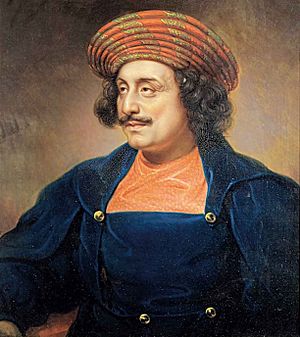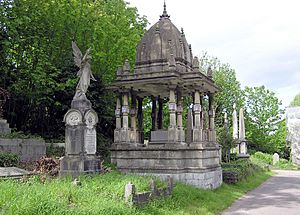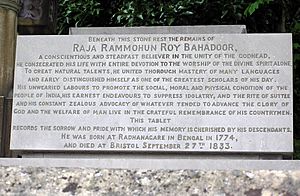Raja Ram Mohan Roy facts for kids
Quick facts for kids
Ram Mohan Roy
FRAS
|
|
|---|---|

Roy in London (1833), by Rembrandt Peale
|
|
| Born | c. 22 May 1772 |
| Died | 27 September 1833 (aged 61) |
| Other names | Herald of New Age, Father of Indian Renaissance |
| Occupation | Social and religious reformer; Brahmin prince, author |
| Known for | Bengal Renaissance, Brahmo Sabha (social, political reforms) |
| Signature | |
Raja Ram Mohan Roy (22 May 1772 – 27 September 1833) was an important Indian reformer. He helped start the Brahmo Sabha in 1828. This group worked for social and religious changes in India.
The Mughal emperor, Akbar II, gave him the special title of Raja. Roy was very active in areas like politics, public service, education, and religion. He is famous for working to stop harmful practices like sati and child marriage.
Roy wrote Gaudiya Vyakaran, which was the first full grammar book for the Bengali language. Many people call him the "Father of Indian Renaissance." This means he helped bring new ideas and changes to India. In 2004, the BBC ranked him as the 10th Greatest Bengali of All Time.
Contents
Early Life and Education
Ram Mohan Roy was born in Radhanagar, a village in the Hooghly District of Bengal Presidency. His family was from a high social group called Kulin Brahmins. These Brahmins were known for marrying many women and taking dowries. Ram Mohan Roy later fought against these practices.
His father was a Vaishnavite (worshipped Vishnu), and his mother was a Shaivite (worshipped Shiva). Roy learned many languages, including Sanskrit, Persian, English, Arabic, Latin, and Greek.
A Shocking Event
When Ram Mohan Roy was young, he saw his sister-in-law die by sati. This was a practice where a widow would burn herself on her husband's funeral pyre. She was only seventeen and very scared. Roy tried to stop it, but he could not. People shouted "Maha Sati!" (great wife) while she was burning. This event deeply affected him.
His Marriages
Ram Mohan Roy was married three times. His first wife died young. With his second wife, he had two sons, Radhaprasad and Ramaprasad. His second wife passed away in 1824. His third wife lived longer than him.
Learning and Beliefs
Roy's early education is not fully clear. Some say he started learning Bengali, Sanskrit, and Persian in his village. Later, he might have studied Persian and Arabic in Patna. Then he went to Benares to learn more about Sanskrit and Hindu scriptures like the Vedas and Upanishads.
Ram Mohan Roy wanted to bring back the pure ideas of the Vedanta philosophy. He taught that there is only one God. He translated old Indian scriptures into English. He also helped start the Calcutta Unitarian Society and the Brahmo Samaj. These groups helped reform and modernize Indian society.
He strongly campaigned against sati. He also wanted to combine the best parts of Western culture with Indian traditions. He opened schools to promote modern education in India. He believed in a Hinduism that was logical, ethical, and focused on social improvement.
Working with the East India Company
In his early years, Ram Mohan Roy worked for the Honourable East India Company. This was a British trading company that ruled parts of India. He also worked as a moneylender and a scholar in English courts. During this time, he started learning Greek and Latin.
Tuhfat-ul-Muwahhidin
In 1804, Roy wrote a book called Tuhfat-ul-Muwahhidin (A Gift to Monotheists). He wrote it in Persian, with an introduction in Arabic. This book showed his early ideas about believing in one God.
Starting the Atmiya Sabha
In 1814, he started the Atmiya Sabha (Society of Friends) in Kolkata. This group was for discussing philosophy. They wanted to spread the idea of one God from the Vedanta. They also worked against idol worship, strict caste rules, and other social problems.
Economic Concerns
Roy noticed that the East India Company was taking a lot of money out of India. He estimated that about half of all the money collected in India was sent to England. This left India with less money for its own people. He thought that allowing more Europeans to settle in India and trade freely might help this problem.
Fighting Social Evils
For many years, Ram Mohan Roy fought against harmful Hindu practices. These included sati, polygamy (marrying many people), child marriage, and the dowry system. He believed these practices were wrong and hurt society.
The Brahmo Period and Reforms
The years between 1820 and 1830 were very active for Ram Mohan Roy. He published many writings during this time. He wrote about Christianity, ancient female rights, and English education. He also started a Bengali newspaper called Samvad Kaumudi in 1821 and a Persian paper called Mirat-ul-Akbar in 1822.
In 1826, he published Gaudiya Vyakaran, the first complete Bengali grammar book.
Founding the Brahmo Sabha
In 1828, he started the Brahmo Sabha with Devendranath Tagore. This group aimed to reform Hinduism and fight social problems. By 1828, he was a very well-known person in India.
Journey to England
In 1830, Roy traveled to the United Kingdom. He went as an ambassador for the Mughal Emperor, Akbar Shah II. His main goal was to make sure that the British government would not cancel the law banning sati. He also asked King William IV to increase the Mughal Emperor's allowance. He succeeded in getting the allowance increased. While in England, he met with members of Parliament and published books about India's economy and laws.
Religious Reforms
Ram Mohan Roy's religious ideas were part of the Brahmo Samaj movement. Here are some of their beliefs:
- They believed that the basic ideas of Brahmoism are found in all religions.
- They believed in one Supreme God. This God has a clear personality and moral qualities. He is the creator and protector of the universe. They worshipped only Him.
- They believed that you don't need a special place or time to worship God. You can worship Him anywhere, anytime, as long as your mind is focused on Him.
Roy had studied the Qur’an, the Vedas, and the Upanishads. His beliefs combined ideas from Hinduism, Islam, and other philosophies like Unitarianism.
Social Reforms
Roy started groups like the Atmiya Sabha to fight social problems. He wanted to bring social and educational changes to India. He fought against superstitions and was a leader in Indian education and journalism.
- He strongly opposed Hindu customs like sati, polygamy, child marriage, and the caste system.
- He demanded that women should have the right to inherit property.
- In 1828, he created the Brahmo Sabha. This was a group of reform-minded Bengali Brahmins who worked against social evils.
Roy believed that the Hindu system needed changes for the good of society. He wanted to show Europeans that the "superstitious practices" in Hinduism were not part of its true spirit. By doing this, he hoped to make Hinduism seem more respected in the eyes of the Christian world.
Educational Reforms
- Roy thought education was key to social change.
- In 1817, he helped set up the Hindu College in Calcutta with David Hare.
- In 1822, he founded the Anglo-Hindu School. Four years later, in 1826, he started the Vedanta College. He wanted these schools to teach modern Western subjects along with his ideas of one God.
- In 1830, he helped Rev. Alexander Duff start the General Assembly's Institution (now Scottish Church College).
- He supported bringing Western learning into Indian education.
- His popular journal, Sambad Kaumudi, discussed topics like freedom of the press. It also talked about giving Indians higher positions in government and separating the government's executive and judicial powers.
- When the East India Company tried to control the press, Ram Mohan wrote two strong protests in 1829 and 1830.
Death and Legacy
In September 1833, Roy became ill in Bristol, England, where he was visiting friends. He was diagnosed with meningitis and passed away on 27 September 1833.
Mausoleum at Arnos Vale

Ram Mohan Roy was first buried in the grounds of Stapleton Grove. Later, in 1843, his body was moved to a new grave at Arnos Vale Cemetery in Bristol. A special monument called a chhatri was built over his grave. It was designed by William Prinsep, who knew Roy in Calcutta.
Every year, remembrance services are held for Raja Ram Mohan Roy at Arnos Vale Cemetery. People from the Indian High Commission and Bristol's Lord Mayor often attend. It's a joint service where prayers and hymns are sung, and flowers are placed on his tomb.
His Lasting Impact

Roy's belief in English education and Western ideas led to discussions among later leaders. Mahatma Gandhi questioned Roy's strong support for Western thought. However, Rabindranath Tagore disagreed, saying that Roy had a deep understanding of Indian wisdom and was not just a student of the West.
Today, there are many tributes to Ram Mohan Roy. In Bristol, there is a large bronze statue of him on College Green. His tomb at Arnos Vale is a historic site and many people visit it. A path in Stapleton is named "Rajah Rammohun Walk" in his honor.
See also
 In Spanish: Ram Mohan Roy para niños
In Spanish: Ram Mohan Roy para niños
- Adi Dharm
- Brahmo
- Brahmoism
- British India Society
- Hindu School, Kolkata
- Presidency College, Kolkata
- Scottish Church College, Calcutta


